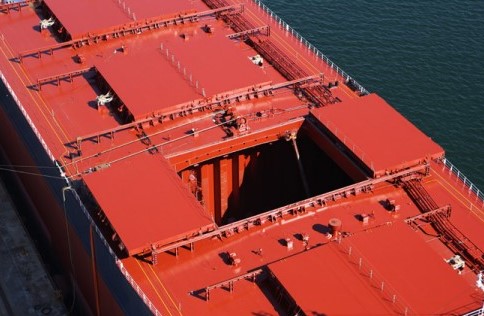Standard Club published a guide to explain the key issues of hatch cover security and to steer mariners towards active maintenance.
As the club says, “ensuring hatch covers are well maintained reduces the number and cost of cargo wet damage claims.” In fact, the most common cause of cargo wet damage claims on dry cargo ships is attributed to leaking hatch covers.
Hatches leak for a variety of reasons, but mainly because of poor maintenance or failure to close them properly. Leaking or badly maintained hatch covers can lead to more serious consequences than wet cargo, including flooding, accelerated corrosion or even loss of the ship. It is crucial for safety at sea and protection of the environment to maintain hatch cover weathertightness and strength.
There is a common misconception and a degree of confusion throughout the industry as to whether hatches are constructed to be watertight or weathertight. A watertight closure is designed to withstand water pressure from both sides of the structure, while weathertight means that regardless of the sea conditions, water will not penetrate into the ship
Standard Club explains,
In addition, hatch covers are constructed to be weathertight, which means that, in any transient condition, water shall not penetrate through the covers or the double drainage system. However, iminor leakage into a cargo hold during a hatch cover test is often erroneously considered to be within a weathertight standard; in practice, no leakage is the standard for weathertightness.
What is more, Standard’s research shows that many mariners consider hatches to be robust, monolithic structures and thereby fail to appreciate the small tolerances on panel alignment and gasket compression. In fact, hatch covers are complex, precision-made structures that need to be handled with care.
In addition, Standard’s condition surveys and claims analysis indicate that, in many cases, hatch cover maintenance is not considered to be important and:
When maintenance is carried out, it is often not done in line with the manufacturers’ guidance or industry best practice
Furthemore, repairs are often only carried out after a ship has failed a hatch cover tightness test at the load port. In such cases, maintenance is often done in haste, in an unplanned manner and without proper carem the guide notes.
Proper maintenance and repair requires a systematic approach, but often crew cut corners in an effort to pass the tightness test as soon as possible, without giving proper regard to the quality of repairs
Safety when working with hatch covers
Considering the above, the avoidance and prevention of injuries is of paramount importance. Before working on a hatch, a risk assessment should be completed to identify all hazards. Control and safety procedures should be examined and modified so that hazards are reduced to minimal levels.
The following points should be borne in mind:
- Always wear the correct protective clothing, boots and hard hats;
- Always test the hold atmosphere before entering;
- Never stand on a moving hatch cover;
- Never stand on a hatch coaming when the hatch is open;
- Never work on a hatch cover when the locking pin or hook is not fitted and secure;
- Never open or close a hatch cover without ensuring the coaming is clear of debris and checking that all personnel are clear of the moving hatch and its channels or wires;
- When opening or closing a hatch, never attempt to clear an obstruction with your hands;
- When hatches are opened at sea, always secure them to the coaming top by lowering the wheels into a guide pocket, or by fixing restraining wires.
































































Helpful